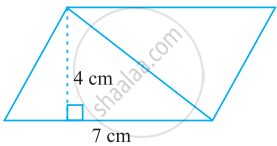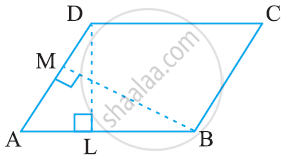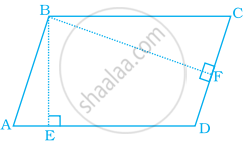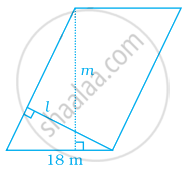Advertisements
Advertisements
प्रश्न
The height of the parallelogram is one-fourth of its base. If the area of the parallelogram is 676 sq.cm, find the height and the base
उत्तर
Let the base of the parallelogram be ‘b’ cm
Given: Height = `1/4` × base
Area of the parallelogram = 676 sq. cm
b × h = 676
b × `1/4`b = 676
b × b = 676 × 4
b × b = 13 × 13 × 4 × 4
b = 13 × 4 cm = 52 cm
Height = `1/4` × 52 cm = 13 cm
Height = 13 cm, Base 52 cm
APPEARS IN
संबंधित प्रश्न
Find the area of the following parallelogram:

DL and BM are the heights on sides AB and AD respectively of parallelogram ABCD (see the given figure). If the area of the parallelogram is 1470 cm2, AB = 35 cm and AD = 49 cm, find the length of BM and DL.

A parallelogram has sides of 15 cm and 12 cm; if the distance between the 15 cm sides is 6 cm; find the distance between 12 cm sides.
The two sides of the parallelogram ABCD are 6 cm and 4 cm. The height corresponding to the base CD is 3 cm.
Find the
(i) area of the parallelogram.
(ii) the height corresponding to the base AD.

What happens to the area of the parallelogram if the base is increased 2 times and the height is halved?
Area of parallelogram ABCD (see the figure) is not equal to ______.

If the sides of a parallelogram are increased to twice its original lengths, how much will the perimeter of the new parallelogram?
To find area, any side of a parallelogram can be chosen as ______ of the parallelogram.
Altitudes MN and MO of parallelogram MGHK are 8 cm and 4 cm long respectively in the below figure. One side GH is 6 cm long. Find the perimeter of MGHK.

Perimeter of a parallelogram shaped land is 96 m and its area is 270 square metres. If one of the sides of this parallelogram is 18 m, find the length of the other side. Also, find the lengths of altitudes l and m in the given figure.

